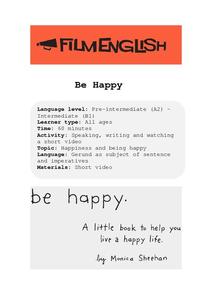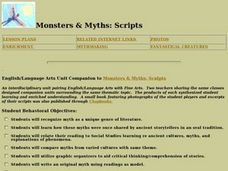Curated OER
Science and Art Museum
Imagine each one of your learners on task and interested in scientific material. Learners investigate science related art by creating a small museum! Using digital cameras, pupils photograph different scientific actions that look...
Curated OER
Connected by Art
Students inspect visual arts by exploring images on-line. In this art analysis instructional activity, students discuss the history of art and the its ability to communicate with people through images. Students utilize pencils and...
Film English
Be Happy
What makes your pupils happy? Find out with a lesson centered around this theme. Class members come up with things that make them happy and write about them in preparation for quick group project. Learners watch and discuss a short film...
PBS
Universal Declaration of Human Rights
What rights are guaranteed to students? Do they align with the Universal Declaration of Human Rights, which was approved by the United Nations in 1948? Middle and high schoolers present persuasive arguments about the rights they believe...
Curated OER
I Have a Metaphor
Learners locate the literary devices used in Martin Luther King Jr.'s "I Have a Dream" speech. In this figurative language lesson plan, students first distinguish between similes, metaphors, analogies, personification, etc. Learners...
Curated OER
Letters from the Heart: Designing for the Other 90% of the World's Population
Young scholars explore varied aspects of the design process and learn that most products are designed to reach the worlds wealthiest 10%. In this lesson, students work in groups to learn ways in which designers are attempting to rectify...
Curated OER
Homophone Cartoons
A terrific lesson plan on homophones awaits your youngsters. First, pupils access a website that contains lists of homophones. Then, it's time to get creative! Everyone gets a piece of poster board and they create a homophone cartoon -...
Collaborative Learning Project
Simple to Complex Sentences
Such a creative game idea, this activity might actually make grammar fun! Learners play a modified game of connect-four by identifying the grammatical name for different words and phrases and then working them into simple sentences to...
Classroom Adventures Program
Creating Characters
Examine character in depth. Over the course of these six lessons, learners explore their own character traits, determine the traits of characters in the books they read, practice comparing and contrasting, and collaborate in small groups...
ReadWriteThink
Exploring Plagiarism, Copyright, and Paraphrasing
Plagiarism, copyright, and fair use are the focus of a three-part instructional activity designed to inform scholars of how to properly cite others' work. First, pupils use a KWL chart to begin thinking and discussing plagiarism. They...
Curated OER
Lincoln 2.0
Students investigate the Presidential history of Abraham Lincoln by completing a multimedia project. In this U.S. politics lesson, students examine the image of Lincoln on a penny and work in groups to research Lincoln's life using the...
Curated OER
Letters to Poets
Add a strong poetry lesson to your literature unit. Middle and high schoolers investigate their writing voices with journaling and group discussion, then choose a famous poet to study. They write letters to their chosen poets, explaining...
Curated OER
Monster and Myths: Scripts
Middle schoolers explore characteristics of the myth genre. In this myth lesson, students become familiar with various myths and the cultures they were derived from. Middle schoolers compare in a graphic organizer. Students write...














